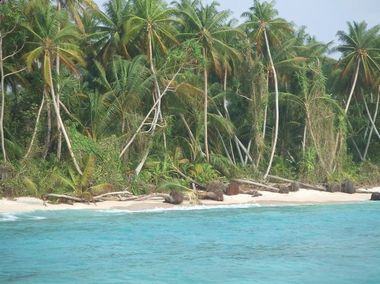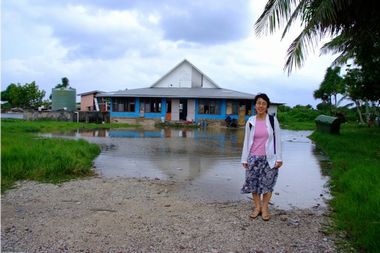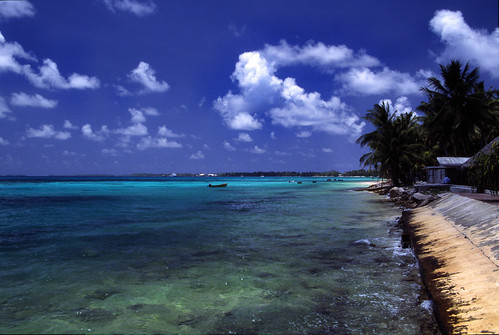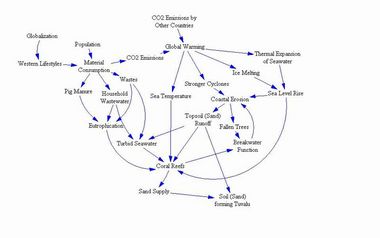June 8, 2010
Report from Tuvalu, a Country Sinking Below the Waves
Keywords: Newsletter
JFS Newsletter No.93 (May 2010)
The chief executive of Japan for Sustainability, Junko Edahiro, visited Tuvalu and wrote for the May 2010 issue of "Nikkei Ecology," a Japanese magazine covering topics of business and the environment. Here's her report.
-----------------------------------------------------
Tuvalu -- a small country in the South Pacific Ocean known worldwide for images in the media of waves washing away at the roots of palm trees on its beaches -- is now regarded among Japanese people as a tragedy of an island nation sinking into the sea and synonymous with being a victim of global warming. On the other hand, people, particularly the skeptics of global warming, claim that "Tuvalu is not sinking, but even if it is sinking, it is not because of global warming."
So what is happening in Tuvalu? Is it really sinking?
In late January 2010, I visited Tuvalu and participated in an eco-tour organized by the non-profit organization Tuvalu Overview. I also talked to the local people and met with Tuvalu's Minister.
Tuvalu is a country in Polynesia consisting of nine islands. Its total land area is about 26 square kilometers, with a population of less than 10,000, half of which lives in the capital Funafuti on the island of Fongafale.
After flying for two hours from Fiji, atolls that looked like ribbons in circles floating in the cobalt-blue ocean started to came into view. My propeller aircraft landed on the deep-green colored island of Fongafale, a flat and slender island averaging only 1.5 to 2 meters above sea level.
"People here are not struggling to escape from sea-level rise." This was my first impression, and I found that I took at face value what has been reported by the Japanese mass media. The Tuvalu I visited is a wonderful island with warm-hearted people. They looked happy and had friendly smiles for visitors. But I still wondered, is this island sinking?
What does the term "sinking island" really mean? In fact, "sinking" here expresses the relative position between the height of the island and sea level. It can be described like this: When you are in a bathtub and warm water is poured into it, it looks like you are sinking. And even if no water is added but you are told to soak up to your shoulders, you also look like you are sinking. In the same way, when the land surface is being washed away by waves, little by little, like a sand castle on the beach, then the island appears to be sinking.
In if Tuvalu is "sinking" it could be a phenomenon of sea-level rise, land subsidence, or coastal erosion -- or a combination of all three.
So, is Tuvalu really sinking? In other words, is sea level rising relative to the land surface? And why could it be happening? Is it sea-level rise due to global warming? Is it the island's subsidence?
Let me explain the island's structure. It is based on an atoll formed by growing coral in the shape of a ring. Dead coral and foraminifera shells accumulate and become sand on the beach. Ecosystems of coral formation and foraminifera constantly provide sand for the island; thus the island's landscape is sustained.
The coral reef, the foundation of the island, is composed of hard limestone structures that are resistant to wave erosion, but sediments on the reef such as fragments of dead coral and foraminiferal shells are easily washed away. I suppose relative sea level might have risen for some reasons and the sandy sediments may have become exposed to wave action. On several occasions, locals told me they had seen an uninhabited islet disappear into the sea in a short period of time.
Land Subsidence Not the Only Explanation
Some researchers claim that sea-level rise in Tuvalu is caused by land subsidence. Some say this due to excessive extraction of groundwater, while others point out that coral-based islands are fragile and collapse easily, or that U.S. forces has done some sloppy land reclamation work. So what exactly is happening in Tuvalu?
The Tuvaluan people have been mainly using rainwater instead of pumping up groundwater for the last several decades, because of a groundwater pollution problem.
It is known that the average rate of subsidence of coral reef islands is 0.02 to 0.2 millimeters per year. In Tuvalu, there are some monitoring sites where the Australian Agency for International Development has been collecting data since 1993 to compare with a fixed benchmark. According to the data collected at those sites, the land movement between 1993 and 2009 was from -1.6 mm to +6.4 mm. Also, monitoring using a global positioning system (GPS) has been conducted since 2002 to measure the ground level, but so far there is no evidence of land subsidence.
Meanwhile, tidal data from a tide gauge installed in Funafuti shows a rise of 5.9 millimeters per year of the mean tide level between 1993 and September 2008. This figure was adjusted for various factors such as vertical ground movement, atmospheric pressure, sea and air temperatures, wind speed, and wind force. For this reason, it is apparent that sea-level rise is exerting greater influence than land subsidence on the changes in relative position of land and sea in the last 15 years.
In the Fourth Assessment Report of the Intergovernmental Panel on Climate Change (IPCC), researchers estimated that global sea levels have risen an average of 17 centimeters in the past 100 years and that the sea-level rise between 1961 and 2003 was 1.8 millimeters per year. The figure from geographic distribution of short-term linear trends in mean sea level for 1993 to 2003 in the IPCC report (Figure 5.15(a)) also shows that Tuvalu is located in an area where sea level has been rising significantly.
The Fourth Assessment Report of IPCC
http://www.ipcc.ch/publications_and_data/ar4/wg1/en/ch5s5-5-2-2.html
As I continued to visit many sites, interview local people, and study literature, I came to understand that the situation cannot be described in a simple way. Statements like "Global warming is causing sea-level rise and small islands like Tuvalu are in danger of being submerged" don't capture the full story. I tried to illustrate the relationships between various factors, based on what I had learned, by drawing a causal-loop diagram (a tool of "systems thinking," a method to guide ideas for desirable change by identifying linkages and underlying structures, beyond time and space, and by viewing the whole instead of each separate factor). Here below is the diagram I drew.
A Complex of Interconnected Factors
Higher temperatures due to global warming cause "thermal expansion" of the ocean and melting of the ice in the Antarctic, Greenland, and continental glaciers, which result in an increase of the volume of seawater and a rise in the sea-level. As sea-level rises, coastal erosion accelerates. Storms intensified by global warming can also accelerate coastal erosion. I saw many fallen trees along the beaches in Tuvalu. When trees fall, the important functions they provide are then lost -- as breakwaters to protect the island from storm surges and wave action and as anchors to prevent soil runoff. A worsening of coastal erosion is the result.

Fallen trees in Tuvalu
Eroded soil accumulates on the coral reefs, hindering coral growth. Turbid seawater blocks sunshine from deeper water and reduced coral photosynthesis. A rise in seawater temperature caused by global warming causes further damage to the coral. These factors threaten the growth and the very survival of coral and foraminifera, which then leads to an insufficient supply of the sand needed to sustain the island.
Evidently, the global impacts of global warming are affecting Tuvalu, causing sea-level rise, coastline erosion, and decreased amounts of soil on land. In fact, the negative effects such as coastline erosion, fallen trees, and damaged corals are visible in Tuvalu.
However, global factors are not the only cause of these damages. Due to the growing population and westernized lifestyle of the Tuvalu people, the volume of household waste and sewage has increased on the island. Because sewage is not treated sufficiently, the wastewater flowing into the ocean carries excess nutrients, and corals are hindered from growing because of algae blooms.
Global and Local Solutions for Tuvalu
Critical data have been collected only in the South Pacific region in the past 20 years or so. This is not a sufficient time to identify long-term environmental trends. Nevertheless, the data indicate two things: (1) Tuvalu is experiencing sea-level rise, and (2) land subsidence, a possible cause of the sea-level rise, is not happening in Tuvalu to any significant extent.
To summarize, many factors have contributed to creating the current situation in Tuvalu, so we would be mistaken to assume that there is one single cause of the Tuvalu problem. There are some other factors involved besides global warming, but we cannot simply exclude it from being the main factor.
Tuvalu's problems have also been worsening because of local factors that increase eventual vulnerability to the bigger problems triggered by global factors. To cope with this deteriorating situation, short-term solutions as well as medium and long-term solutions need to be devised and implemented.
We have to deal with both global and local issues. If we focus too much on global issues, there is a risk that the impact of local issues could be underestimated; however, an excessive focus on local issues will not reveal the ultimate solutions to the problems.
Global factors will increasingly affect Tuvalu in the future. The IPCC predicts that the global average rise in sea level by the end of the twenty-first century will be in the range of 18 to 59 centimeters, while the Potsdam Institute for Climate Impact Research in Germany estimates it will be nearly two meters.
It is Tuvalu's responsibility to tackle its local problems, while at the same time sending a warning to the world about global warming. And the world's nations, including Japan, must waste no time in addressing the global factors. Ultimately, such actions are not just to save "our dear Tuvalu," but also to save ourselves.

Written by Junko Edahiro
Related
"JFS Newsletter"
- 'Good Companies in Japan' (Article No.4): 'Eightfold Satisfaction' Management for Everyone's Happiness
- "Nai-Mono-Wa-Nai": Ama Town's Concept of Sufficiency and Message to the World
- 'Yumekaze' Wind Turbine Project Connects Metro Consumers and Regional Producers: Seikatsu Club Consumers' Co-operative
- Shaping Japan's Energy toward 2050 Participating in the Round Table for Studying Energy Situations
- 'Good Companies in Japan' (Article No.3): Seeking Ways to Develop Societal Contribution along with Core Businesses




